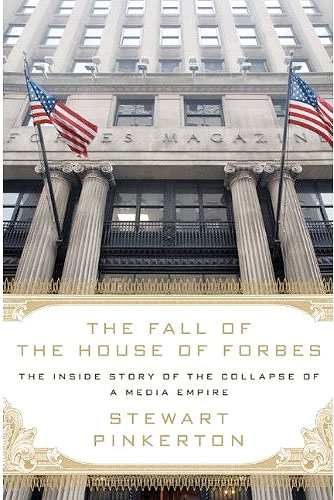The quintessential story in Forbes magazine for the past four decades includes some attitude and presents a contrarian point of view to the conventional wisdom about a company. Using that formula, former Forbes managing editor Stewart Pinkerton presents a behind-the-scenes look at how the magazine thrived during the first two generations of ownership by the Forbes family but is currently struggling to remain competitive in the cutthroat world of business journalism.
“The Fall of the House of Forbes: The Inside Story of the Collapse of a Media Empire“ is an easy read that provides valuable lessons for anyone interested in business journalism or the rapidly changing media business. It explains what worked — and more recently, what didn’t — at the biweekly magazine in both its reporting and writing and in its operations. In addition, it’s an interesting history of one of the top magazines of the past 100 years.
Bertie Charles Forbes founded the magazine in 1917 after a career writing for newspapers in South Africa and in New York, where he made a name as the business columnist for the New York American, a Hearst paper.
The magazine was known in the early years for being a voice for business, although B.C. Forbes did warn his readers to get out of the market before the October 1929 crash that led to the Great Depression. By the 1930s, however, he was faced with competition from McGraw-Hill’s BusinessWeek, which launched in 1929, and Time Inc.’s Fortune, which started in February 1930, and was third in circulation by the end of the decade. Only Forbes’ syndicated column kept the business afloat.
The early Forbes magazine did have its high points. The first issues included a section for women in business, a rarity in the early 20th century. It used focus groups to determine what readers wanted. And Forbes billed the publication as telling the story of how businesses – and their owners – could succeed and make everyone happy.
When he died in 1954 while sitting in the magazine’s lower Manhattan offices, Forbes was replaced by his son Malcolm, who had started his own magazine while an undergraduate at Princeton. Although he had joined Forbes in the 1940s, Malcolm Forbes had other interests too. He wanted to be a politician, and unsuccessfully ran for governor of New Jersey before focusing on the magazine in 1957.
It was under Malcolm Forbes that the publication began to thrive. To combat the Fortune 500 list of top companies, Forbes started its own list of the richest people in the world, and that issue remains the magazine’s top seller. It now produces dozens of other lists, including the most powerful women in business and the richest people in Hollywood.
Forbes began selling itself as the embodiment of a successful businessman, and Malcolm Forbes lived the lifestyle, becoming the biggest advertisement for business success. He bought a ranch in Colorado and homes in Morocco and England, and ballooned around the world. His yacht, the Capitalist Tool, came to symbolize the rewards of being a successful business, as did his collection of Faberge eggs and Impressionist paintings.
However, Pinkerton — who worked at the magazine for two decades – credits much of Forbes’ success to longtime editor James Michaels, who took over as editor in 1961 and remained at the top for 37 years, editing virtually every word published during that time span. It was Michaels, despite his irascible nature, who built the magazine’s reputation as one that wouldn’t shy away from criticizing companies and executives it considered failures and frauds — as long as Malcolm wasn’t pushing an article about a major advertiser or friend to be watered down.
The magazine didn’t surpass BusinessWeek and Fortune in terms of ad pages until the 1990s, when Forbes was being run by the third generation.
But it’s the current members of the Forbes family that Pinkerton blames for its current business problems that have caused them to sell off many of the houses and paintings that Malcolm had purchased.
According to Pinkerton, the operation has been slow to integrate its online and print newsrooms, which led to competing fiefdoms. It also put family members in management positions that they were unsuited to handle, and expanded into international markets by picking poor business partners.
The Forbes family has now sold a 40 percent stake in the company to outside investors who are pushing for changes, but Pinkerton believes the editorial strategy, which includes providing blog space on Forbes.com to companies, is flawed, and that the changes being made may be too late to save the company.
He believes that the Forbes name has lost its brand appeal because Malcolm Forbes’ sons abandoned the magazine’s original strategy of promoting business as a means to happiness. And James Michaels, who died in 2007, is turning over in his grave in upstate New York.









